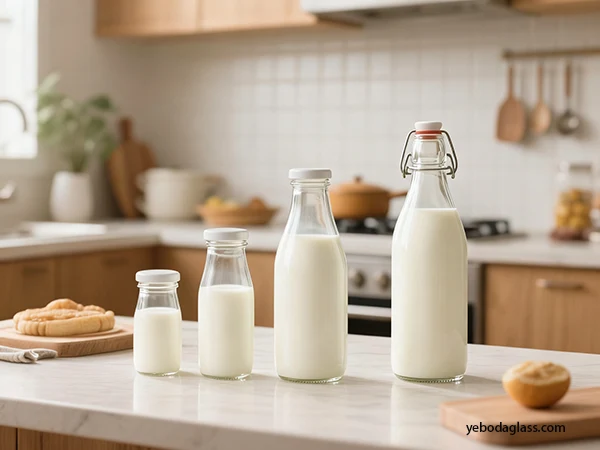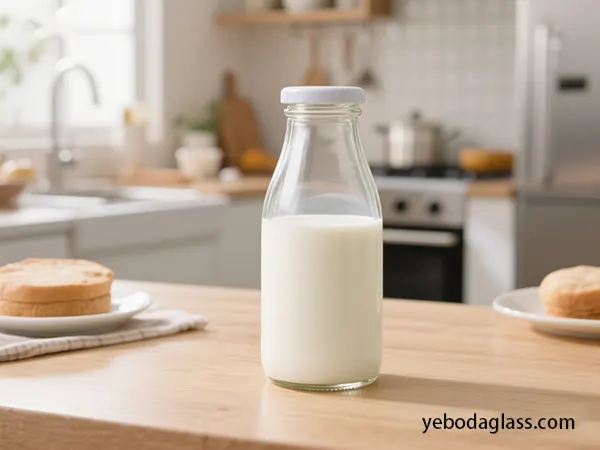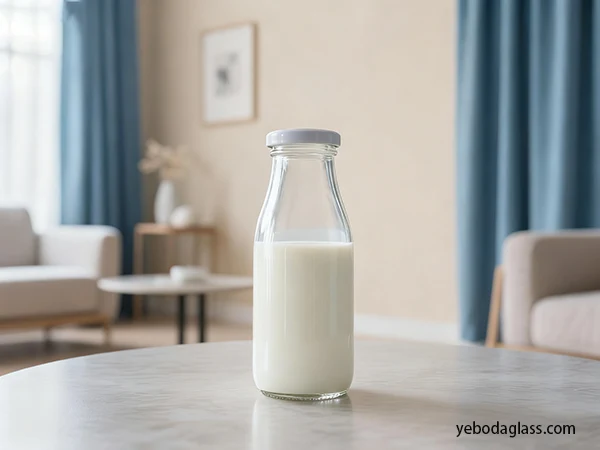giriiş
Milk bottle wholesale customization is a key factor in how companies set themselves apart in a market with a lot of competitors. Besides material standardization, the customization parameters become the company’s personality and simultaneously satisfy the need for operations and the demand for the market. Evet, evet. milk bottle wholesale company, being an innovator, guarantees the money-to-value ratio, great design, and high-quality standards for every batch of production.

Considering The Primary Material
Material selection is a sign of a company’s customization, pricing and branding vision. Glass, PET, and HDPE are the common materials for the purpose of each having different advantages and disadvantages in a breakdown of durability, recyclability, aesthetics, and customization. Glass offers a premium feel but is heavy and fragile. PET and HDPE are lighter, more durable, and economical if produced annually in large volumes, but they might not be able to convey the same high-end image. The brands have to decide on their values and market expectations to be able to guide the choice of materials.
Estimated Product Volume
The volume of a product determines the processes of production as well as the techniques of customization that are suitable. The small-bech product is suitable for digital printing and low flexibility and setup costs. Milk bottles of a large capacity will need processes that are fast, efficient, and automated such as flaxographic printing, shrink sleeves, and in-mold labeling for the reduction of the unit cost to be in the bulk volume. Knowing the scales is the best way to select the right investment and supply chain.
Target Demographic Analysis
One of the factors that specializes in brand identity optimization is understanding the target demographic. Design, materials, and sustainability all depend on the age, income, lifestyle, and purchasing habits of the demographic. For example, Yeboda milk bottles wholesale, made of glass with minimalist designs, might be preferred by a premium, eco-conscious audience, while the family market might prefer durable, lightweight plastic options with vibrant graphics. Defining attributes of the audience is equally important for both market penetration and loyalty.
Existing Brand Guidelines
Brand guidelines that exist for a brand are non-negotiable in terms of brand consistency across all the brand touchpoints. These consist of exact details for the logo, color palette (CMYK, Pantone), typography, imagery, and visual hierarchy. Milk bottle personalization needs to follow these brand guidelines so that the milk bottle as a product is an easy way to the brand’s established identity. The changes of the brand identity are the reasons for the brand to become weaker. A brand style guide is exhaustive and elemental.
Primary Distribution Channel
The distribution channel which the product is intended for has a significant effect on the packaging design and the packaging materials used. Products in bottles that are to be sold directly to consumers, in retail stores, or in institutional foodservice comprise the category of uniquely challenging ones. E-commerce or home delivery needs transit packaging that is robust. The retail packaging must have a high degree of shelf appeal and the barcode must be placed in such a way that it is distinctive. Being aware of these needs early on makes it possible to have customized bottles that are both intact and presentable, thus showing the quality of the brand.
Material Selection and Customization Impact
Materials profoundly influence a bottle’s functional properties, customization techniques, brand perception, sustainability, and structural design. Each material—glass, PET, and HDPE—offers unique properties to meet project needs and brand objectives.
Cam Şişeler: Premium Appeal and Versatility
Fayda:
- Perception of The Premium: Get associated with quality, freshness, and better consumer experience.
- Excellent Barrier Properties: Glass is impermeable, thus protecting milk from oxygen, moisture, and other contaminants.
- Geri Dönüştürülebilirlik: 100% infinitely recyclable without quality or material losses.
- Customizability: It is possible to do printing, etching, frosting, and embossing on it.
- Heat Resistance: It can endure quite high temperatures for pasteurization and sterilization.
Boundaries:
- Weight and Fragility: It makes transport more expensive and the possibility of the bottle breaking during handling high.
- Maliyet: The plastic part will always be cheaper than glass, but an attempt is made to compensate for this by increasing the value of the packaging.
Πλαστικό (PET, HDPE):
PET remains the packaging material that is closest to an ideal combination of its high transparency, low weight and nice balance among durability, performance, and cost-effectiveness.
Fayda:
- Şeffaflık: The material is nearly completely transparent.
- Low weight: This is the main reason why the vehicle is less expensive than those made of glass.
- Dayanıklılık: The product is less likely to break, so it is a safe alternative for large milk bottles.
- Geri Dönüştürülebilirlik: Most of the world (#1 resin code) can recycle it.
- Tasarım Esnekliği: It enables various shapes and sizes to be produced via molding.
Boundaries:
- Bariyer Özellikleri: The defense against oxygen is not as strong as that of glass.
- Heat Sensitivity: It sets restrictions as far as pasteurization is concerned.
- Perception: The bottle becomes less visually attractive and less premium.

HDPE (High-Density Polyethylene) Bottles: Robustness and Cost-Effectiveness
HDPE is the most commonly used material for milk bottle bulk of large quantities because of its strength, opacity, and cost-effectiveness.
Fayda:
- Dayanıklılık: Resistant to impact to a great extent.
- Cost-effectiveness: Reasonable for large-scale productions.
- Opacity: It shields milk from light decay.
- Geri Dönüştürülebilirlik: It is possible to recycle it from almost anywhere (#2 resin code).
Boundaries:
- Estetik: Not as good as glass or PET in terms of luxury.
- Bariyer Özellikleri: Does not provide a complete oxygen barrier.
The Impact of Milk Bottle Wholesale on Optimization Technology
The decision of what material to use sets the optimization methods that are available for the bulk of milk bottles:
- Bardak: Direct screen printing, etching, and embossing are the most suitable techniques.
- PET: The best compatibility is with shrink sleeves, pressure-sensitive labels, and digital printing.
- HDPE: Generally, it is altered by in-mold labeling (IML) and flexographic printing.
Main Customization Techniques for Milk Bottle Wholesale
After the choice of materials, customization with brand identity is the only way to distinguish a brand from the crowd and at the same time make it an unmissable presence.
Direct Printing Techniques
Direct printing carries ink directly onto the surface of the milk bottle, resulting in a simple and harmonious design.
Serigrafi Baskı
The production of glass bottles, and to a lesser extent plastics, benefits from this vibrant, long-lasting finish. The appearance of custom milk bottle wholesale with the help of this method becomes one of the highest levels of a design.
Dijital Baskı
The method is suitable for small runs, personalization, or a few copies of limited editions. It allows for rapid prototyping with minimal setup costs.
Flexographic Printing
It is the most efficient method when the milk bottle wholesale is targeted to a large-scale production; the technique is compatible with HDPE or PET materials.
Advanced Labeling Solutions
Labels offer freedom in both visual and information selection aspects.
Pressure-Sensitive Label (PSL)
Provides versatility and is a money-saving option for all types of materials, which additionally can contain multi-color and even graphics that are vibrant.
Shrink Sleeves
Can be used as a 360-degree branding tool and add a sophisticated touch to retail milk bottle packaging.
Wet Glue Labels
Only after detailed factory audits and validate checks are the finalists selected.
In-Mold Labeling (IML)
Perfect for HDPE bottles, fusing labels directly during molding for durability.
Structural Modifications
Beyond decoration, bottle form itself enhances branding.

Embossing and Debossing
Adds tactile, premium feel with the brand integrated into the bottle structure.
Custom Bottle Shapes
Creates proprietary brand recognition; ideal for high-end milk bottle wholesale differentiation.
Integrating Brand Guidelines and Design
Seamlessly integrating brand guidelines ensures all customized milk bottles align with established identity and market presence.
Logo Placement and Prominence
Strategic logo positioning ensures visibility and recall, typically in the bottle’s upper third.
Color Palette Application
Color consistency is key—use precise Pantone/CMYK matching for all milk bottle materials.
Typography Consistency
Adhere to approved fonts and maintain readability across materials and printing methods.
Visual Hierarchy and Information Architecture
Identify and legally compose product name, brand, and related information clearly to continue the visual charm as well as conform to legal standards.
Brand Storytelling and Imagery
Adopt an imagery and a message that truly reflect the integrity of the product, its sustainability, and its origin.
Production Volume, Scalability and Cost Optimization
The extent of production sets the stage for viable customization, cost management, and scalability.
Effect of Production Quantity
For small runs, it is more beneficial to utilize digital printing; For big runs, one should employ flexography or in-mold labeling.
Scalability Considerations
Improve your manufacturing efficiency and supplier availability capacity through design to pave the way for further expansion and growth.
Cost Optimization Strategies
Utilize mass buying, standardisation, and mechanization to lower general unit costs in large milk bottling operations.
Milk bottle wholesale distribution channels, packaging durability and shelf appeal
The distribution channel has a major impact on packaging design which calls for durability, logistics efficiency, and visual appeal.
Distribution Channel Requirements
- Spices such as turmeric and paprika are photosensitive. UV-Sleptical glass bottles, foil laminations, and photocromic materials end the color and prevent the decline in taste. Concentrate on both product attractiveness and barcode-readability.
- Food Service: Sturdiness and the possibility of using it with one hand should be the main characteristics taken into consideration.
- E-commerce: Make sure that the product is shock-resistant and firmly held in place.
Packaging Durability
Support material strength, print longevity as well as closure integrity so the brand image is not lost throughout the distribution channel.
Shelf Appeal and Consumer Engagement
Incorporate intriguing shapes, top-notch finishes along with recycling cues for an appeal to the trendy consumers.

Emerging Trends and Sustainable Customization in Milk Bottle Wholesale
Environmental concerns, digital technologies, and individualization are totally changing the milk bottle wholesale business.
Eco-Friendly Materials and Circular Economy
Use PET, HDPE and recycled glass to reduce the carbon footprint and to meet the requirements of the circular economy standards.
Advanced Digital Printing
Variable data printing (VDP) allows for personalization, traceability, and the production of limited-edition runs.
Akıllı Paketleme Teknolojileri
Add features such as QR codes, NFC tags, and freshness indicators for consumer interaction as well as for easy monitoring along the supply chain.
Refillable and Reusable Systems
Support the use of durable glass bottles in closed-loop models that result in decreased waste and bring about environmental sustainability.
Minimalist Design and Transparency
One of the most prominent minimalist designs features transparent products or at least transparency about the products and their origins.
- Clean Aesthetics: These are simple, uncluttered designs that focus on the purity of the product and the quality of the material. In the case of a clear Yeboda glass milk bottle wholesale, the milk’s natural color is the main visual element.
- Honesty: Concentrating on one thing only, being truthful when telling the story of ingredients, sourcing, and brand values.
- “Naked” Packaging: Aesthetic and environmental benefits are evident as the trend of label reducing or elimination, depending on the branding by direct printing or structural elements, continues to grow.
It is possible for milk bottle wholesale operations to enjoy the benefits of these emerging trends and sustainable solutions, which are in line with consumer demands that keep evolving, thus being able to position themselves as leaders in innovation and environmental stewardship, which makes them retain brand relevance and success in the long run.




